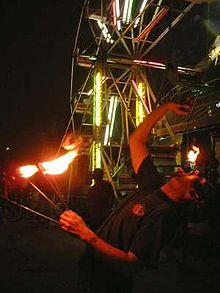Fire swallowing
When swallowing fire (not to be confused with spitting fire ) the fire artist extinguishes a burning torch in his mouth.
technology
When the fire is swallowed, the flame of the torch is suffocated. The fire artist slowly brings the torch to his mouth and exhales easily (the strength when pronouncing H. This is done all the time until the torch is in the mouth.) When the torch is in the mouth, the mouth is closed. This will suffocate the fire. It takes long practice to do it safely.
Tricks
Many fire-eaters also master tricks like holding the torch between their teeth and re-igniting the torch with fuel residue on their lips.
hazards
Burns
If the fire artist does not exhale or even inhale hard enough, the flame strikes the throat, causing burns to the nose and even to the throat.
lung infection
When fuel is inhaled from the torch, it enters the lungs, where it causes considerable damage (depending on the type of fuel). This so-called lipid pneumonia or "chemical inflammation" is triggered by the destruction of the phospholipid film in the alveoli and can lead to fatal pulmonary edema or severe bacterial pneumonia . This mechanism is independent of the agent used or its purity and is only caused by its physical properties. Persistent coughing fits are serious warning signs of lipid pneumonia.
Poisoning and irritation
Many of the fuels used to swallow fire are harmful or even toxic . Poisoning is also caused by ingestion or inhalation of the vapors of the fuel or the fuel itself.
literature
- Patrick Fonger: Fire-swallowing and fire-breathing. 4th edition. Aragon Verlag, Moers (1st edition 1997), ISBN 3-89535-432-5 .
